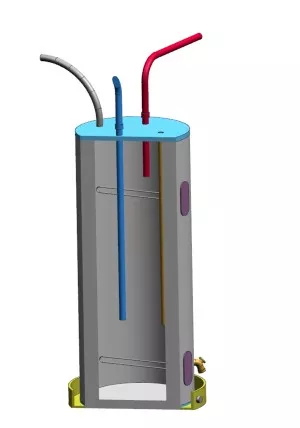- Home
- Troubleshooting Water Heaters
- Water Heater Is Leaking From the Bottom
What to Do if your Water Heater is Leaking from the Bottom? Troubleshooting and Repairing Tips.
 Gas water heater (photo: Rheem)
Gas water heater (photo: Rheem)If you notice that your water heater is leaking from the bottom, it can be a frustrating and concerning issue. Not only can a leaking water heater cause damage to your home, but it can also increase your energy bills and pose a safety hazard.
In this context, we will explore the common reasons of the problem, including potential causes such as a faulty TPR valve, drain valve, or tank corrosion. We will also provide tips on how to troubleshoot and repair the issue, helping you to restore your water heater to full functionality and prevent further damage.
So let's see what you can do about this problem, can you take a shower if it is leaking, and is it dangerous.
Water heater is leaking from the bottom: Things to consider
Before attempting the repair
If your water heater is leaking, there are several things you should consider before attempting to repair it.
First, it's important to determine the severity of the leak. A small drip may be a minor issue that can be easily fixed, while a large leak could be a sign of a more serious problem.
Next, consider the age of your water heater. If your water heater is approaching the end of its lifespan, it may be more cost-effective to replace it rather than repair it.
It's also important to think about your safety. If you're unsure about how to troubleshoot or repair your water heater, it's best to consult a professional to avoid any potential hazards.
In general, there are several reasons why your water heater is leaking from the bottom. This is not an uncommon problem and can often be mixed up with the leak from the top.
We'll look at some of these reasons in a while. If you notice a leak, it is important not to ignore it. Instead, we recommend that you:
- Find the cause of the leak.
- Take steps to prevent additional water damage as much as possible.
- Turn off the gas, power, and water supply to the water heater.
- Determine whether to repair the element or connection, or replace the entire water heater.
To turn off the power to an electric water heater, locate the circuit breaker for the water heater and switch it to the OFF position.
To turn off the power to a gas water heater, locate the gas shutoff valve on the supply line and close it (the valve handle should be perpendicular to the gas line).
Finally, use the shutoff valve on the cold water supply line to close off water delivery to the tank.
Signs that show your water heater is leaking from the bottom
To avoid personal injury and property damages, it is important to know the signs of a leaking water heater. Here are some:
- No hot water from the faucets
- Loss of pressure in the faucets
- Puddle of water at the base of the unit
- Wet or stained surfaces on ceilings and drywalls
Is leaking from the tank dangerous?
A leaking water heater can be dangerous if it is not addressed promptly. The severity of the danger depends on the cause and location of the leak.
If the leak is due to a faulty TPR (Temperature-Pressure-Relief) valve or a malfunctioning thermostat, the water in the tank could become overheated and under high pressure, which can cause an explosion or fire. This is especially dangerous for gas water heaters.
If the leak is due to corrosion or rust on the tank's bottom, the tank could weaken and eventually burst, causing flooding and property damage. This is especially true for tanks installed in the attic.
If left untreated, wooden objects and drywalls can get wet and develop mold and mildew (see how to get rid of mold at home).
If the tank water is scalding hot, you might get burned upon contact.
If the problem is small, you can still take a shower, but be careful. Limit water usage until your plumber arrives and repairs or replaces your water heater.
The reasons why your water heater is leaking from the bottom
There are several reasons why your gas or electric water heater may be leaking from the bottom. Whether you need minor repairs or a complete replacement depends on where you find the leak. Below are a few places where a water heater might be leaking and their causes. We'll also show you what to do about the leak and how to prevent further water damage to your property.
Temperature & pressure relief valve (TPR) is leaking
 T&P valve (photo: AO Smith)
T&P valve (photo: AO Smith)One problem area when it comes to water heater leaks from the bottom is the temperature and pressure relief valve.
The TPR valve is a safety device installed in the hot water tank. Its job is to release hot water and lower the pressure when the water in the heater gets too hot or when there's too much water pressure in the tank. It has a discharge tube that runs from the valve and ends a few inches from the floor.
The discharge tube, also known as the overflow pipe, directs water discharge or leaks from the valve downwards and safely to the drain, preventing water from spraying out onto nearby objects or people. If you notice water at the bottom of your hot water tank, check the discharge tube to see if it is releasing any water.
If the TPR valve is faulty, you may need to replace it, tighten the connection, or get a plumber to fix the problem. It's important to get this repaired quickly because running hot water without the TPR is dangerous. Do not try to fix the valve; it's safer to replace it. Alternatively, you may just need to reapply Teflon tape or pipe dope.
A leaking or faulty drain valve
 Drain valve (photo: AO Smith)
Drain valve (photo: AO Smith)Another possible cause of a water heater leaking from the bottom is a drain valve. The drain valve is located at the bottom of the tank and is used for flushing or draining the water during routine maintenance.
It's worth noting that regular draining of the tank is important to remove sediment buildup, which can reduce efficiency and cause damage to the tank and its components if left unchecked.
How does a faulty drain valve cause a water leak?
Sometimes, it could just be that the drain valve is not completely closed. If you notice that water is leaking through the spigot, just tighten the knob, and it might stop leaking.
However, after tightening the knob, the outlet might still be dripping water. If that happens, then the drain valve is faulty or clogged and needs attention. Check out this guide on how to replace a drain valve.
Leaking from the inside (condensation in the combustion chamber)
Another area where leaking could occur is due to condensation, which is more noticeable when temperatures are at their lowest in early spring and winter.
For example, condensation can occur when an empty hot water tank is suddenly filled with cold water, similar to a glass of ice water on a hot day.
Filling a water tank with cold water while the burner is on can cause condensation. The combustion process produces moisture, which then condenses on the cooler surfaces of a water tank. When the condensate, such as water droplets, falls on the burner and other hot surfaces, it produces a sizzling noise.
Excessive condensation can cause water to run down the flue tube and onto the main burner, obstructing the ignition system and resulting in the pilot outage. This could also make you think that a water heater has a leak. However, giving it some time to warm up may fix the problem.
So, what exactly causes condensation?
Well, there are several reasons why condensation might occur in your water heater. Some of these include:
- When the water heater is running for the first time and filled with cold water.
- High demand for hot water, causing the tank to be refilled with cold water very quickly and in a short time.
- Gas burns might produce vapors in high-efficiency models with lower flue temperatures.
Interestingly, any one of these conditions could make you think that the water heater is leaking from the bottom. One way to avoid these issues is to make sure that you choose the right size water heater for your household's hot water demands.
To determine if the suspected leak is actually just condensation, start by cleaning up the puddle of water that has collected beneath the water tank. Then, observe to see if the water reappears or not. If it doesn't, then it's likely just condensation. However, if the water is still dripping even after the water in the tank has warmed up, then condensation is probably not the issue.
How to minimize condensation on a hot water tank
To avoid the problem of condensation, there are a few steps you can take:
- Increase air circulation around the tank and clean the flame arrestor underneath.
- Reduce indoor humidity using a dehumidifier.
- Insulate the hot water tank with an insulation blanket (and consider insulating pipes with foam sleeves).
- Add heat to the surrounding area to reduce the temperature difference between inside and outside if condensation persists.
Leaking connections
Actually, when you suspect a leak, this is one of the first places to check. Often faulty or loose connections can cause a leak. So, it's a good idea to look through all the connections to the water heater to be sure that none is loose. You might also need to reapply the Teflon tape or pipe dope.
Leaking tank
Note that most of the leaks come from the hot water tank itself. A leaking tank is often caused by the buildup of sediment and corrosion. Therefore, it is crucial to drain your tank regularly to prevent sediment buildup and keep it performing as designed. Sediment buildup can cause rust and cracks in the metal tank over time.
Typically, a leak from the tank means the water heater will need to be replaced. In this case, you should have a plumber to investigate further, or you can simply purchase a new water heater.
If you want to avoid potential leaks from a tank-type water heater, you should consider getting a tankless water heater instead. This is because tankless water heaters do not have a storage tank and rarely leak. Even if they do, they can be repaired because each element can be replaced, eliminating the need to replace the entire unit.
Conclusion
If you notice that your water heater is leaking from the bottom, it's important to address the issue as soon as possible to prevent further damage. If you have experience with plumbing repairs, you may be able to fix the problem yourself and save money. However, if you're unsure or uncomfortable with DIY repairs, it's best to seek assistance from a professional. By taking action promptly, you can prevent the problem from becoming more serious and avoid costly repairs or replacement in the future.
- Home
- Troubleshooting Water Heaters
- Water Heater Is Leaking From the Bottom



